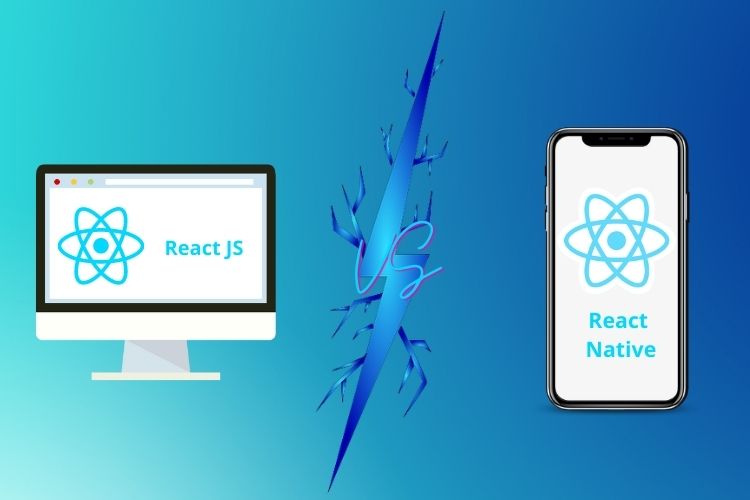If we talk about the app development market, React JS and React Native are two of the most widely used technologies. Both of these frameworks have identical names and were created by Facebook. Despite their similarities at their foundation, React and React Native differ significantly. Many people in the community, however, are still confused about the differences between React JS vs React Native. Apart from the fact that one is a web development framework and the other is a mobile app development framework, there is a lot of gray area. Before we discuss the comparison between React Native and React JS, as well as their benefits and drawbacks, and explain how React Native differs from React JS. Let us know what React JS and React Native.

What is React JS?
Today, React JS is one of the most widely used JavaScript libraries. Startups and huge organizations utilize it to create single-page apps and mobile apps. Facebook and Instagram use React JS in their mobile apps. React JS is a JavaScript package that is used to create the view layer of online and mobile apps. It builds a stronger structure for its applications by reusing components. So, you can contact React JS development company to create your web application.
Benefits of React JS
As we know what is React JS, so let us discuss its features of the React JS:
- Speed is a distinct selling point: React JS will improve the efficiency of your application in the blink of an eye thanks to its virtual Document Object Model (DOM) functionality. React JS will first create an in-memory data cache to configure differences, which will then be automatically updated in the DOM.
- Dynamic applications: This is the most outstanding tool for creating a user-friendly web application with minimal coding.
- JavaScript syntax is available: This capability comes in helpful when you need to define your application’s user interface.
- One-way data-binding feature: This feature puts you in command and allows you to correct mistakes. When making a tiny adjustment, for example, the entire parent component does not need to be rewritten. It provides a level of code stability not seen before the introduction of React JS. The kind of stability that makes React JS application maintenance a breeze.
- Components-based Frameworks: One of the most appealing aspects of React JS is the ability to split it into numerous components. Alternatively, you can utilize it to pass data across your app without altering the DOM.
- Use HTML: The good news is that React JS allows you to access libraries while using HTML. Programming has never been more approachable!
- SEO-boosting functionality: React JS supports SEO optimization by facilitating faster site indexing. In exchange, SEO optimization helps the website succeed by allowing the content to be indexed at the server level. So, this means more leads for business owners and web developers.
- Fast Website Loading: One thing that React JS ensures is a lower user bounce rate. When comparing React and React Native, web page analytics is an important feature that could sway developers. When a web page takes too long to load, the user navigates to another website that loads faster. That’s where React JS comes into play.
- Reusable Components: One of the best advantages of the React JS is that it has the ability to reuse components. So, when you hire React JS developer for your web app, they do not have to write the codes for the different apps. This feature facilitates faster development at a low cost.
Hence, you can engage with React JS development company to create your web application at a low cost.
What is React Native?
React Native is an open-source technology created by Facebook to satisfy its rising mobile demands. It is a great way to create native mobile apps with reusable components that can run in JavaScript on platforms including Windows, Android, and iOS. React Native, for example, uses React JS for the base abstraction; only the library components are different. In fact, if you want to create an app for both platforms, get mobile app development services from a well-known agency.
Benefits of React Native
Above, we have to define what React native is? So, let us explain the benefits of using React Native.
- Accessible to the Mobile app: To increase the performance or want to integrate with the other mobile app, the developer uses React Native’s API.
- Unique architecture: It has a flexible architecture that makes coding simple for any mobile app developer.
- Versatile CocoaPods Compatibility: You can use React Native with your iOS coding project because it includes a versatile CocoaPods compatibility feature.
- Compatible with JavaScript: React Native is interoperable with JavaScript, making it one of the most user-friendly frameworks.
- Focuses on User Interface: If you want a framework that you can tweak and make interactive, React Native is the way to go.
- Hot Reload: React has the Hot Reloading feature that allows developers to reload a mobile app automatically. Also, it speeds up the development process and saves time.
- Save time and Money: React Native saves you time and money by allowing you to minimize your code density and build cross-platform applications. You’ll save time because you do not have to write the code for each mobile application. You may also reuse your codes across a wide range of mobile devices, such as iOS and Android. As a result, In-app maintenance expenditures are also getting low.
React JS vs React Native: What’s the Difference?
The primary difference between React JS vs React Native is that React JS may run on any platform, but React Native cannot. Many features distinguish React JS from React Native. For starters, developers and programmers can use React JS to create a high-performance UI as their own JS library. You can develop the complete framework with React Native, regardless of whether you’re using iOS or Android.
Security
React JS provides the best security when compared to React Native. Because of its mobile nature, React Native’s security can be lacking.
Animation
Another significant distinction between React and React Native is that React JS allows for more eminent animation at higher levels than React Native. It’s done mostly with React JS and CSS, whereas React Native relies on API to generate animation. Nonetheless, both are used in web development and mobile app development since they are both adaptable and offer reusable components that boost functionality at the same time.
Computations vs. Mobile Apps
React Native also performs better in mobile apps and regular calculations and computations. On the other hand, React JS is better at handling more complex computations. And it is used in a wide range of applications.
Libraries
Because it is only a library at its core, React JS has a lot of constraints. React JS is a JavaScript library that enables professionals to create an engaging and high-performing User Interface Layer. In contrast, React Native is a framework rather than a language library. Moreover, the web application built with React JS renders HTML in UI, whereas React native uses JSX for rendering.
Different Components
The components differ between React and React Native. React JS is a web DOM base, but React Native is a derivation of it. To put it another way, the components are distinct. While the flow appears to be identical, there are some functional distinctions.
Code Rendering
A primary distinction between the two is how the code is rendered. React JS allows you to render code from the DOM, but React Native allows you to use APIs in mobile apps. Styling approaches differ as well. You may use CSS with React JS and stylesheets with React Native, for example, and it also affects how you use animation. Meanwhile, React JS will provide developers with more safe and accessible choices for creating high-performing animations.
If a business owners want its web app to be built with a responsive, high-performing UI, React JS is the best choice. And, if the need is to provide a mobile app with a native feeling, React native is good.
Navigation
React Navigation is powered directly by React and is fully integrated with JavaScript, making it perfect for web application loading. React Native is a little trickier because it uses its own React native framework to browse mobile apps and provide important mobile performance.
Final Words
After reading this article, you will have a better understanding of the differences between React JS vs React Native and the benefits. Are you still undecided about the best framework to use? While both frameworks have a lot to offer, it’s important to remember that React JS and React Native are essential focal points for web and app development.
You will be bombarded with upgrades and updates in an environment where technology is evolving and can be a pain. However, you cannot expect everything to run smoothly. All you need is a sufficient quantity of ability and knowledge to get started. In the end, after you’ve decided what kind of app you want to build, picking between React JS and React Native should be a piece of cake.


